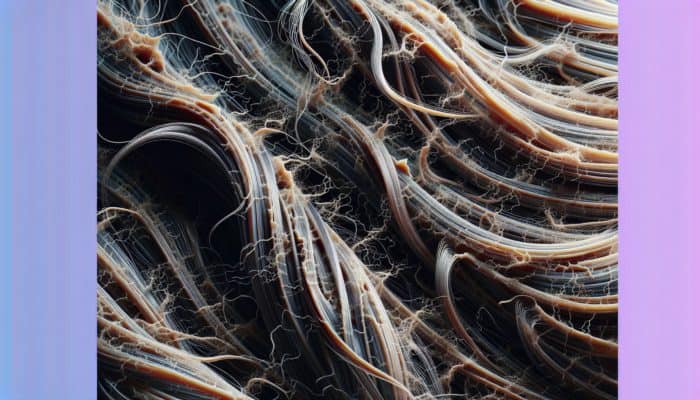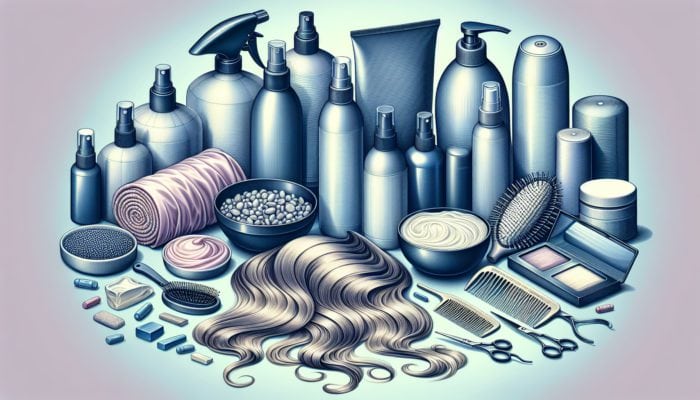In-Depth Analysis of Heat Damage and Effective Hair Recovery Techniques
Identifying the Key Factors Leading to Hair Damage from Heat Exposure

Heat damage is a prevalent issue that arises from prolonged exposure to elevated temperatures, particularly when utilising styling tools such as straighteners, curling tongs, and hair dryers. These devices can reach temperatures above 200 degrees Celsius, which severely compromises the structural integrity of the hair. The application of heat disrupts the protein structure of the hair, resulting in weakened strands that are brittle and significantly more prone to breakage. Additionally, styling frequently without appropriate protective measures exacerbates the problem, underscoring the importance of understanding these contributing factors to develop effective repair strategies tailored to your hair’s specific requirements.
Beyond the direct impact of heat, various environmental elements, including humidity, UV exposure, and pollution, can significantly exacerbate heat damage. For instance, individuals living in warmer climates may experience accelerated moisture loss from their hair, leading to increased dryness and a lacklustre appearance. By recognising these external influences, you can implement proactive strategies that are in harmony with your specific environment and lifestyle. Establishing a customised hair care routine will bolster your hair’s resilience against damage, ensuring it stays healthy and vibrant.
Understanding the Profound Impact of Heat on Hair Structure
The effects of heat on the structural integrity of hair are severe and can often be irreversible if not addressed in a timely manner. Heat exposure can denature the protein keratin, which is essential for maintaining hair strength, causing it to become brittle and susceptible to splitting and breakage. Damage to the hair cuticle—the protective outer layer—compromises its ability to retain moisture, leading to a dry, frizzy appearance. Understanding these detrimental effects is crucial not only for implementing efficient repair strategies but also for taking necessary precautions to protect your hair from future harm.
Changes in the texture of hair typically manifest as a rough feel, diminished shine, and increased frizz. When hair suffers from heat damage, it may also lose its natural elasticity, complicating styling and management. Acknowledging these alterations highlights the necessity of using targeted treatments and products specifically formulated to cater to the unique needs of heat-damaged hair, thereby paving the way for effective recovery and revitalisation.
Recognising the Initial Indicators of Heat Damage in Your Hair
Identifying the early signs of heat damage is essential for effectively reversing its harmful effects. Common indicators include split ends, which occur when the hair’s protective cuticle is compromised, alongside a noticeable lack of natural shine and increased frizz due to the lifting of the cuticle that permits uneven moisture penetration. Take a moment to assess your hair following heat exposure—if it feels dry, appears limp, or has a rough texture, these are clear signals indicating that it requires immediate attention and care.
Another significant symptom to be mindful of is tangling, which can occur when rough cuticles catch on one another. Early recognition of these warning signs enables timely intervention strategies, such as implementing a nourishing conditioning routine and refraining from further heat styling practices. By being observant and acknowledging these changes, you can take swift action to restore your hair’s health and vitality, ensuring it remains vibrant and resilient.
Proven Techniques for Effectively Repairing Heat Damage

Choosing the Most Effective Products for Hair Damage Restoration
Selecting the appropriate products for repairing heat damage is a crucial stage in your recovery journey. When choosing hair care items, place emphasis on key ingredients known for their restorative properties. Some vital components to consider include:
- Keratin – Aids in replenishing lost protein and strengthening hair strands.
- Argan Oil – Rich in fatty acids, it provides deep hydration and nourishment.
- Coconut Oil – Recognised for its ability to penetrate the hair shaft, effectively hydrating and protecting.
- Panthenol – A form of vitamin B5 that enhances moisture retention and imparts shine.
- Aloe Vera – Delivers soothing hydration and supports the repair process.
- Shea Butter – Functions as a natural moisturiser that retains essential moisture.
Utilising products infused with these ingredients can significantly promote the recovery of heat-damaged hair. Additionally, seek out leave-in conditioners and reparative hair masks specifically designed for damaged strands. By ensuring that you provide your hair with the nourishing care it needs, you will facilitate the restoration of its vitality and strength.
Applying Effective Deep Conditioning Techniques for Optimal Hair Recovery
Deep conditioning is an essential technique for revitalising heat-damaged hair, and there are numerous effective routines to incorporate. For instance, a weekly deep conditioning treatment using a rich, hydrating mask can yield impressive results. To create an effective regimen, begin by washing your hair with a gentle shampoo to eliminate any product buildup. Once your hair is clean, generously apply the deep conditioner, concentrating on mid-lengths to ends, where damage is often most pronounced.
To enhance effectiveness, consider applying heat during the conditioning process; wrapping your hair in a warm towel or using a heated cap can significantly improve product absorption. A popular choice is a DIY coconut oil mask, celebrated for its nourishing properties. Simply warm the oil slightly, apply it to your hair, and let it sit for a minimum of 30 minutes before thoroughly rinsing. By regularly incorporating such routines into your hair care regimen, you can observe remarkable improvements over time, restoring your hair’s vitality and softness.
Determining the Optimal Frequency for Hair Treatments

The frequency of hair treatments largely hinges on the severity of the heat damage experienced. For mild cases, incorporating a deep conditioning treatment once a week may suffice, while more severe damage might require bi-weekly treatments to encourage optimal recovery. Being attuned to your hair's condition is crucial; if it feels dry or appears dull, it may indicate the need to increase the frequency of your treatments to promote better healing.
In addition to deep conditioning, contemplate integrating leave-in treatments and serums into your daily routine. These products can offer continuous hydration and protection, ensuring that your hair remains resilient against environmental stressors. Remember that consistency is paramount; regular application can lead to significant improvements in hair health, making your efforts both worthwhile and beneficial.
Proactive Strategies to Prevent Future Heat Damage
The Critical Importance of Heat Protectants in Hair Care
Investing in a high-quality heat protectant is vital for safeguarding your hair against damage caused by styling tools. The most effective heat protectants contain a blend of ingredients that create a barrier against high temperatures while simultaneously providing nourishment. When selecting a heat protectant, look for these essential features:
- Thermal Protection – Creates a protective shield against excessive heat.
- Moisturising Ingredients – Infused with oils or butters for added hydration.
- Lightweight Formula – Ensures it does not weigh hair down unnecessarily.
- UV Protection – Shields against sun damage, particularly beneficial for outdoor styling.
By incorporating a heat protectant into your styling routine, you can significantly diminish the risk of further heat damage. Applying it to damp hair before blow-drying or using it as a finishing touch before flat-ironing can make a remarkable difference in preserving your hair’s health. Being proactive in your hair care will contribute to maintaining its beauty and vitality over the long term.
How to Modify Your Heat Styling Habits for Healthier Hair
Adjusting your heat styling habits is a fundamental step in minimising heat exposure. Begin by assessing the temperature settings of your styling tools—reducing the heat from high to medium can markedly decrease potential damage. Aim to utilise heat styling tools only when absolutely necessary, and whenever viable, consider air-drying your hair to minimise heat application.
Moreover, strive to alternate between different styling techniques to limit excessive heat exposure on any one area of your hair. For example, if you’ve used a curling iron this week, consider braids or buns the following week to create waves and texture without needing heat. Embracing natural styles can significantly reduce the frequency of heat applications, promoting healthier hair in the long run.
The Crucial Role of Regular Trims in Hair Health Maintenance
Regular trims are essential for sustaining healthy hair and preventing the advancement of damage. By trimming away split ends and any damaged strands, you promote healthier growth and prevent splits from travelling up the hair shaft, which can result in more extensive damage. A general guideline is to schedule a trim every six to eight weeks, tailored to your hair type and growth rate.
Additionally, regular trims can help maintain the shape and style of your hair, making it easier to manage overall. When combined with a comprehensive hair care regimen, these trims can significantly enhance the overall health of your hair, ensuring it remains vibrant and full of life, ready to withstand the demands of daily styling and environmental stressors.
Natural Solutions for Effective Repair of Heat Damage
Harnessing the Power of Oils in Hair Recovery
Natural oils provide a wealth of benefits for effectively repairing heat damage, with certain oils distinguished for their efficacy. Coconut oil is often hailed as a miracle worker; its unique molecular structure allows it to deeply penetrate the hair shaft, delivering hydration and repair. Similarly, argan oil is abundant in essential fatty acids and antioxidants, contributing to the nourishment and protection of hair against further damage.
Other notable oils include jojoba oil, which mimics the natural oils of the scalp, and olive oil, known for its emollient qualities. Applying these oils can yield incredible benefits; they not only provide moisture but also form a protective barrier around each strand. Consider incorporating a hot oil treatment into your routine—heat the oil of your choice, apply it to your hair, and leave it for at least 30 minutes before shampooing for optimal results and recovery.
Creating DIY Hair Masks for Nourishing Treatments
Homemade hair masks can offer substantial nourishment and repair for heat-damaged hair, often utilising ingredients readily available in your kitchen. One popular recipe involves mashing a ripe banana and blending it with a tablespoon of honey and coconut oil. This combination not only provides moisture but also revitalises dry strands. Allow the mask to sit for approximately 30 minutes before rinsing thoroughly to reveal softer, more manageable hair.
Another effective DIY option is a yogurt and olive oil mask. Yogurt contains lactic acid, which gently exfoliates and cleanses the scalp, while olive oil provides deep hydration. Apply this mask to both your hair and scalp, leaving it on for up to an hour for a nourishing treatment that can restore moisture and shine. Such masks are not only economical but also allow you to tailor the ingredients to your preferences and specific hair needs.
Utilising Herbs to Enhance Hair Care and Repair
Incorporating herbs into your hair care routine can significantly amplify your efforts in repairing heat damage. Herbs like rosemary and chamomile are renowned for their soothing and restorative properties. Rosemary, in particular, promotes blood circulation in the scalp, supporting healthy hair growth while imparting a lustrous shine.
Additionally, hibiscus is beneficial for strengthening hair and preventing breakage. You can create a herbal rinse by steeping dried hibiscus flowers in hot water and using the cooled liquid as a final rinse after shampooing. Infusing your hair care regimen with these natural elements not only aids in healing but also offers a delightful and aromatic experience as you care for your hair.
Key Vitamins and Minerals Essential for Optimal Hair Health
The significance of diet in maintaining hair health cannot be understated, especially when discussing essential vitamins and minerals. Biotin, often referred to as the “hair vitamin,” plays a crucial role in keratin production, which strengthens hair. Likewise, zinc is vital for hair tissue growth and repair.
Incorporating foods rich in omega-3 fatty acids, such as salmon and walnuts, can further enhance hair health by providing essential fats that support a healthy scalp. If your diet is lacking these vital nutrients, consider taking supplements, as they can significantly contribute to the repair of heat-damaged hair. A balanced diet filled with these essential nutrients will not only improve hair health but also bolster overall well-being, promoting vitality and resilience.
The Multifaceted Benefits of Aloe Vera in Hair Repair
Aloe vera is a powerhouse ingredient in hair repair thanks to its soothing and healing properties. Renowned for its moisturising capabilities, aloe vera can deeply condition hair while fostering healthier growth. Its anti-inflammatory properties can alleviate irritation on the scalp, particularly beneficial if heat styling has caused discomfort or sensitivity.
To harness the comprehensive benefits of aloe vera, consider using fresh aloe vera gel or products with high concentrations of aloe. Apply it directly to your hair and scalp, allowing it to sit for a minimum of 30 minutes before rinsing thoroughly. The results are often softer, more manageable hair and a healthier scalp environment that encourages growth and effective repair.
Exploring the Connection Between Diet and Hair Health
Identifying Essential Nutrients for Promoting Hair Growth
A well-balanced diet plays a pivotal role in supporting hair growth and repair. Essential nutrients such as biotin, zinc, iron, and vitamins A, C, and E are fundamental in promoting healthy hair. Biotin, in particular, is vital for keratin synthesis, the primary protein in hair. Foods abundant in biotin include eggs, nuts, and whole grains, making it easy to incorporate into your daily meals.
Zinc is another crucial nutrient; it facilitates tissue growth and repair, making it essential for maintaining healthy hair follicles. You can find zinc in foods such as shellfish, legumes, and seeds. Ensuring your diet is rich in these essential nutrients will yield significant benefits for your hair, aiding in reversing any damage caused by heat while promoting overall health and vitality.
Understanding the Importance of Hydration for Effective Hair Repair
Hydration is crucial for overall health, and it directly affects hair health as well. Sufficient water intake helps keep hair hydrated from within, enhancing elasticity and decreasing the risk of breakage. Dehydrated hair can become dry and brittle, increasing susceptibility to damage from styling tools.
Aim to consume at least eight glasses of water daily to maintain optimal hydration levels. Additionally, enhance your hydration through water-rich foods, such as cucumbers, oranges, and strawberries. Incorporating more of these hydrating foods into your diet will not only support your hair but also contribute to your overall well-being and vitality, fostering a healthier lifestyle.
Identifying Foods to Avoid for Optimal Hair Health
Just as certain foods can promote hair health, others can exacerbate damage. Processed foods and those high in sugar can lead to inflammation and hinder nutrient absorption, ultimately harming your hair. Foods like sugary snacks and sodas can induce spikes in blood sugar, resulting in hair loss and weak strands.
Furthermore, excessive consumption of caffeine and alcohol can dehydrate the body, directly impacting hair hydration levels. Focus on a diet rich in whole foods, including fruits, vegetables, lean proteins, and whole grains, to effectively support your hair health. By avoiding known culprits of hair damage, you can cultivate an environment conducive to growth and effective repair, enhancing your hair's overall quality and resilience.
Research-Driven Approaches for Effectively Reversing Heat Damage
Findings from Clinical Studies on Effective Heat Damage Repair
Recent clinical studies have validated the effectiveness of various strategies in reversing heat damage. For example, research indicates that products containing keratin can significantly improve hair strength and resilience following heat exposure. Implementing a structured hair care routine that incorporates regular deep conditioning treatments has also been shown to effectively restore moisture levels.
Moreover, studies highlight the advantages of natural oils, such as coconut oil, in minimising protein loss from hair during heat styling. These findings reinforce the necessity of utilising targeted treatments and products specifically formulated for heat-damaged hair. By embracing these evidence-based approaches, you can substantially enhance your hair recovery efforts and achieve optimal results.
The Long-Term Advantages of Consistent Hair Care Practices
The long-term effects of adhering to consistent hair care practices are remarkable. Individuals who maintain a structured routine that includes regular treatments, trims, and protective styling frequently report significant improvements in overall hair health over time. This consistency not only aids in mending existing damage but also ensures that hair remains resilient against future stressors.
Additionally, closely monitoring your hair's condition and adjusting your routine as necessary can lead to lasting results. A long-term commitment to your hair care regimen can result in visibly healthier, shinier, and more manageable hair, making it a worthwhile investment in your personal care routine and overall self-esteem.
Expert Recommendations for Addressing Severe Cases of Heat Damage
In cases of severe heat damage, experts recommend a multifaceted approach to achieve optimal results. A combination of professional treatments—such as deep conditioning or protein treatments at a salon—paired with a robust at-home care regimen is often the most effective strategy for recovery.
For instance, professionals may suggest a series of keratin treatments followed by the application of nourishing masks and leave-in conditioners at home. Furthermore, maintaining a healthy diet and scheduling regular trims should not be overlooked, as these are foundational elements of effective hair care. Engaging with experts for personalised guidance can provide a clear roadmap to restoring your hair's health effectively and sustainably.
Innovative Tools and Technologies Enhancing Hair Care
Discovering the Latest Devices for Effective Hair Restoration
Innovative technologies in hair care have emerged, transforming approaches to repairing heat damage. Devices such as infrared hair dryers and steam straighteners offer gentler heat applications, significantly reducing the risk of damage while styling. Infrared dryers, for instance, emit longer wavelengths of light that penetrate the hair shaft, enabling faster drying without excessive heat exposure.
Moreover, certain styling tools now feature temperature sensors that automatically adjust to the hair’s moisture levels, ensuring optimal heat is utilised for styling without compromising hair integrity. These advancements not only enhance styling efficiency but also prioritise hair health, making them essential tools for anyone aiming to avoid heat damage and maintain beautiful hair.
The Transformative Impact of Smart Brushes on Hair Health
Smart brushes represent a groundbreaking innovation in hair care, equipped with built-in sensors that monitor hair health in real-time. These devices can analyse variables such as moisture levels and elasticity, providing personalised recommendations for care. For instance, a smart brush might suggest using a deep conditioning treatment if it detects dryness or brittleness in your hair.
By integrating technology into your hair care regimen, you can gain insights that guide your styling practices and help prevent future damage. These smart devices empower you to make informed decisions about your hair care, facilitating a tailored approach that prioritises the overall health and vitality of your strands.
The Expanding Role of Technology in Hair Care Solutions
The role of technology in hair care is rapidly evolving, offering tools that not only enhance styling but also repair and protect hair from damage. From applications designed to monitor your hair health and provide customised routines to advanced hair treatments that utilise nanotechnology, the hair care landscape is undergoing significant transformation.
For example, some companies are developing products that deliver active ingredients more efficiently through innovative formulations, ensuring your hair receives the nourishment it requires. By embracing these technological advancements, consumers can adopt a more effective and proactive approach to hair care, solidifying their commitment to maintaining healthy, beautiful hair while countering the effects of heat damage.
Enhancing Hair Products Through Nanotechnology
Nanotechnology is making significant strides in the hair care industry, offering the potential to revolutionise how we treat and protect our hair. This technology allows for the formulation of hair products that can deliver active ingredients at a molecular level, enhancing their effectiveness in repairing heat damage.
For instance, nanoparticles can penetrate the hair shaft more efficiently than traditional formulations, ensuring that moisturising and reparative ingredients reach deeper layers of the hair. By opting for products enhanced with nanotechnology, you can experience improved results in terms of hydration, strength, and overall hair health, making these products invaluable additions to your hair care arsenal.
Establishing a Sustainable Hair Maintenance Routine Following Repair
Creating an Effective Post-Repair Hair Care Regimen
Once you have successfully repaired heat damage, establishing a consistent post-repair routine is vital for maintaining optimal hair health. This includes regular conditioning treatments and protective styling options, such as braids or buns, that minimise exposure to heat and environmental stressors that can lead to further damage.
Incorporate leave-in conditioners and serums into your daily regimen to ensure ongoing hydration and protection. Furthermore, consider alternating between heat styling and heat-free styles to give your hair ample opportunities to recover fully. By committing to a robust post-repair routine, your hair can remain healthy, vibrant, and less susceptible to future damage, allowing you to appreciate your hair’s natural beauty.
Monitoring Your Progress in Hair Health
Keeping track of your hair’s health progress allows you to make informed adjustments to your care routine. Regular assessments of your hair’s condition can help identify areas needing additional attention, such as dryness or breakage. By documenting your hair’s condition through photos or journaling, you can visually track improvements and determine which treatments are most effective for your specific needs.
Additionally, consider conducting regular evaluations of your hair’s texture and shine. If you notice changes indicating that damage is re-emerging, it may be time to reassess your routine and increase the frequency of treatments or dietary adjustments. Monitoring your hair health ensures that you remain proactive in your approach, leading to sustained improvements and overall hair vitality.
Implementing Long-Term Strategies to Sustain Hair Health
Long-term strategies for maintaining hair health focus on prevention and consistent care. Using heat protectants every time you style, adhering to a balanced diet rich in essential nutrients, and committing to regular trims can substantially lower the risk of heat damage over time.
Moreover, incorporating restorative treatments, such as weekly deep conditioning and natural oils, into your routine will ensure that your hair remains well-nourished and resilient against damage. Embracing a holistic approach to hair care—focusing on both external treatments and internal nutrition—will foster ongoing hair health, enabling you to enjoy beautiful, vibrant hair for years to come.
Commonly Asked Questions Regarding Heat Damage and Hair Care
What constitutes heat damage in hair?
Heat damage refers to the deterioration and alteration of hair caused by excessive heat exposure from styling tools, leading to dryness, brittleness, and increased breakage.
How can I determine if my hair is experiencing heat damage?
Common signs of heat damage include dullness, split ends, frizz, and a rough texture. If your hair feels dry and lacks elasticity, it may indicate heat damage.
Which products are most effective for repairing heat damage?
Seek hair care products that contain keratin, argan oil, coconut oil, panthenol, and aloe vera to effectively repair heat damage.
How often should I deep condition my hair?
For mild heat damage, deep conditioning once a week is generally adequate. In cases of more severe damage, consider bi-weekly treatments for optimal recovery.
Are natural remedies effective in reversing heat damage?
Yes, natural remedies such as DIY hair masks made with ingredients like honey, coconut oil, and avocado can be quite effective in repairing heat damage.
What dietary changes can significantly support hair health?
Incorporating foods high in biotin, zinc, omega-3 fatty acids, along with ensuring adequate hydration, are essential for supporting hair health and repair.
Can smart brushes contribute to improved hair health?
Yes, smart brushes equipped with sensors can provide insights into your hair’s condition, helping you make informed care choices to prevent and repair heat damage.
What is the role of technology in modern hair care?
Technology has introduced innovative tools and products that enhance styling and repair, helping to protect hair from damage while promoting overall health and vitality.
How can I maintain healthy hair after repairing heat damage?
Establish a consistent hair care routine that includes regular conditioning, protective styling, and diligent monitoring of your hair health to prevent future damage.
What practices should I avoid to protect my hair from heat damage?
Avoid excessive heat styling, processed foods high in sugar, and neglecting hydration, as these factors can contribute to hair damage and overall poor health.
Connect with us on Facebook!
The Article: Strategies for Reversing Heat Damage: Universal Solutions appeared first on Amitys Hair Salon.
The Article Reversing Heat Damage: Effective Strategies and Solutions Was Found On https://limitsofstrategy.com

